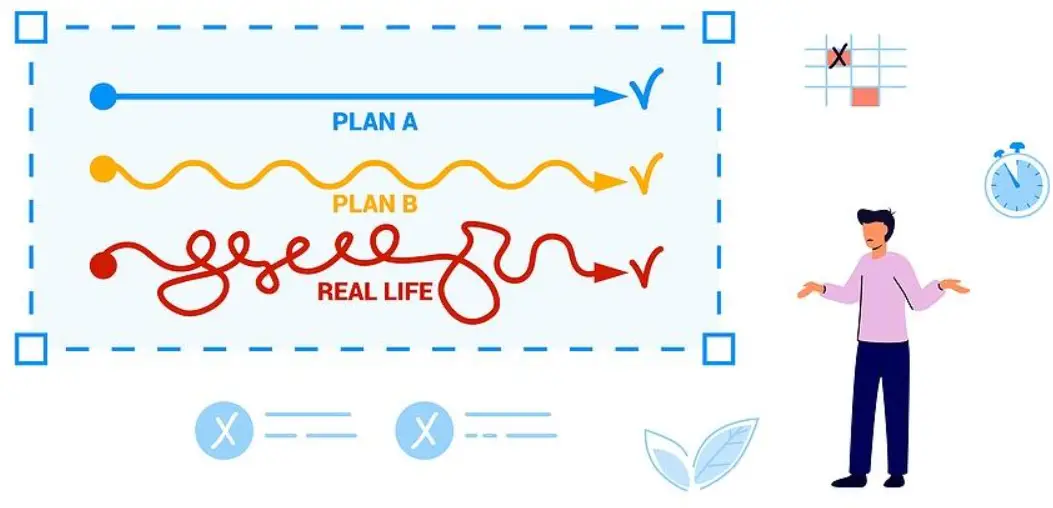🏢 9,000+ Organisations
🏆 6 x L&D/HR Awards
⭐ 4.8/5 Highly Rated
🧠 24 Years' Experience

Whether you lead a team of two or 200, you likely utilise many different leadership approaches based on the situation, the people you’re guiding, and the desired goal.
Did you know that there’s a name for this type of leadership? Yes, here’s another definition of leadership for you.
It’s called contingency leadership.
Below, you’ll learn about the contingency theory of leadership, how it works, its benefits, and how you can start practising it.

The contingency approach to leadership centres around the idea that to be effective in their role, a leader’s style must be appropriate to the situation to be effective in their role.
If a leader only has one strategy up their sleeve, they will be very effective in some cases and entirely ineffective in others. The contingency theory provides a potential solution to this problem.
Practising the contingency leadership style involves examining the situation first, then adjusting your response as a leader according to that context (or changing the person in charge of leading to best suit the situation).
Being flexible in your approach is something that we cover in our Management Training Courses, Team Leader Training and Supervisory Courses. As well as in our Leadership Training, which is built to help managers adapt and lead effectively, no matter the challenge.
A few different versions of the contingency leadership model exist. The following are some of the variations you may utilise as a manager or team leader:
The Fiedler Model is a two-step approach. First, the leader must evaluate their own leadership style. Then, they must consider three key factors — all of which contribute to “situational favourableness” — to be successful.
The Fiedler Model is unique because it also states that leadership styles are fixed. If someone’s leadership style does not fit a situation, that person must be replaced by someone else who practises a different approach.
To identify your leadership style, you must first identify the co-worker you enjoy working with the least. Then, rate that co-worker based on a series of adjectives laid out in the Least Preferred Coworker (LPC) scale.
If you rate your LPC highly, you’re a relationship-oriented leader. You see the best in people, even those you don’t particularly like.
If you rate your LPC less favourably, you’re a task-oriented leader. You struggle to see certain people’s contributions because you value efficiency and effectiveness over other vital attributes.
The next step is evaluating the favourableness of various situations. The favourability varies based on your influence and power as a team leader.
Determine favourableness based on the following:
After you have evaluated the situation’s favourableness, you can decide if you’re the right fit to lead.
Task-oriented leaders typically do the best work in highly favourable and highly unfavourable situations. Relationship-oriented leaders usually do the best work in moderately favourable situations.
Sometimes referred to as the Situational Contingency Theory of Leadership or the Hersey-Blanchard model, the Situational Leadership model says that leaders must adapt their leadership style to best fit team members and their unique abilities.
Unlike the Fiedler Model, which states that leadership styles are fixed, the Situational Leadership Model states that leadership styles can and should change.
The primary focus of this model is team member maturity.
High-maturity employees have more experience and can make decisions on their own.
Moderately mature employees have the capability to make good decisions, but they may lack confidence. On the flip side, they may also be confident but unwilling to complete tasks that have been assigned to them.
Low-maturity employees are enthusiastic and willing to get things done, but they also lack the needed skills or experience.
The Situational Leadership model also posits that leaders should choose between four leadership styles based on their employees’ maturity:
When using the delegating style, leaders allow team members to be responsible for specific tasks to lead smaller groups. This approach works best for high-maturity employees.
When using this style, leaders encourage team members to share ideas and decisions. This approach works well for moderately mature team members who need help building confidence or further developing their skills.
The selling style requires a leader to sell team members on an idea with clear and persuasive instructions. This approach is helpful for moderately mature team members — specifically those with confidence but an unwillingness to complete tasks.
The telling style involves explicit directions and close supervision. It works best for low-maturity employees who are willing but lack the skills to act independently.
The Path-Goal model involves identifying processes or paths that set team members up to meet individual objectives or goals.
Leaders who practise this approach adjust their behaviours and expectations to encourage maximum productivity. They must be very flexible and willing to meet each team member’s needs.
Those who practise the Path-Goal model will alternate between these four leadership approaches:
The leader tells employees what’s expected of them and tells them how to perform certain tasks. This approach is the most effective when an employee’s role is unstructured, or the task is ambiguous.
The leader sets ambitious goals for employees, expects a high level of performance, and has complete confidence in them and their abilities. This approach works well in environments that attract high-achieving employees (hospitals, labs, law firms, etc.).
The leader consults with their employees and asks for their input before making decisions. This approach works well in environments where employees are personally invested in their work and outcomes.
The leader is as concerned with employees’ mental health and well-being as they are with productivity and results. This approach works well in stressful or mentally challenging environments.
The Decision-Making model is also known as the Vroom-Yetton contingency model or the Normative Decision Theory. It’s centred around the idea that decision-making is a crucial component of effective leadership and determines the relationship between the leader and their employees.
Leaders who practise the Decision-Making model demonstrate one of these five leadership styles:
Autocratic (A1)
Leaders believe they have all the information needed to make good decisions. They don’t need any input from their team.
Autocratic (A2)
Leaders consult with their team as a group and then make the final decision alone.
Consultative (C1)
Leaders consult with their team members individually, consider everyone’s view, and then make the final decision alone.
Consultative (C2)
Leaders consult at a broader level with team-wide meetings and then make the final decision alone.
Collaborative (G2)
Leaders care about reaching a consensus. They organise meetings to discuss the situation and ask every team member for their opinion. Then, everyone makes the final decision together by voting.
The various contingency leadership models mentioned above all centre around the idea that the best leaders are adaptable. They understand that their effectiveness is contingent upon their ability to read the room and adjust their approach based on numerous factors, including the following:
Below are some additional elements to keep in mind when considering utilising the contingency theory of leadership:
The contingency theory of leadership provides a lot of value to managers and team leaders because it encourages them to be realistic. It prompts them to evaluate situations and see team members as unique individuals rather than trying to implement a one-size-fits-all approach.
Contingency thinking also allows for more creativity and flexibility in the workplace. Leaders and managers can adjust their approach based on each situation and the capabilities or experience level of their team. These adjustments create opportunities for them to think outside of the box and find new solutions.

Whichever model of the contingency perspective on leadership you decide to practise, the most crucial factor to remember is that you must evaluate each situation and make the best decision based on your relationship with your team members, the amount of time required to complete a task, etc.
Great leaders are willing and able to adjust their approach and choose a leadership style that yields the desired results. Here are some contingency theory examples to help you understand how you might practise it in the real world:
Let’s say you were recently hired at a start-up company to co-manage the marketing team (the members have worked together for the last year). Here are some details you notice when evaluating the team:
Poor relationship between you (the leader) and the current members
• They have a close bond, and you’re an outsider
Low task structure
• Everyone collaborates on every project, and responsibilities are unclear
Low position power
• You have a co-manager who has existing relationships with the team and can veto your decisions
According to Fiedler’s Contingency model principles, a task-oriented leader is the best fit for this situation. It has a high level of unfavourableness, and those who are relationship-oriented may struggle to yield positive results.
In this situation, you’ve been a member of a development team for a long time, and you recently received a promotion to a leadership role.
These key details will influence your leadership approach:
Positive relationships between you and the current team members
High task structure
• The team has been working together for years and has clearly outlined tasks and processes
Low power position
• You’re a team leader who can assist other members, but you don’t have decision-making power when it comes to hiring or firing
With a mixed bag of favourableness-influencing factors, a relationship-oriented approach is likely the most effective option. Prioritising and nurturing relationships will help you and your team maintain a high level of productivity and achieve your goals.
Imagine you’re a sales team leader who recently hired a new salesperson with no previous experience.
According to the Path-Goal model, the best approach would likely be directive leadership.
You would provide detailed instructions, show them how to complete various tasks, set clear expectations, and explain the rewards the employee will earn if they meet expectations. Then, you’ll closely supervise them and offer ongoing guidance as needed.
Let’s say you and your team are supposed to have an important meeting. However, you find out at the last minute that some key members cannot attend. You decide to cancel the meeting.
This is an example of A1 (Autocratic) leadership. You make an executive decision that you believe is the best fit without seeking input from other team members.
A graphic design team lead delegates a task
In this scenario, you establish specific style guidelines and a budget for an upcoming graphic design project.
Once you’ve clarified these restraints, you assign a few team members to the task and give them the freedom to carry out the project with little oversight from you.
This is an example of the delegating style from the Situational Leadership model. You have a group of high-maturity employees who can be trusted to complete a project on their own without you micromanaging them.
Now that you understand the contingency theory of leadership and the power of contingency thinking, are you ready to start practising it?
The more you know about different leadership styles, the easier it will be to evaluate various situations and choose the best response for your team, yourself, and your company.
MTD Training offers numerous courses to help you expand your knowledge of various leadership approaches. Our Management Skills Training and Online Management Courses will provide you with the skills and behaviours to improve your leadership skills.
If you’re looking to take a management assessment, please check out Myers Briggs, DISC or SDI.

Written by Sean McPheat
CEO of MTD Training and Amazon bestselling author. Sean writes about leadership, business, and personal growth, drawing on 20+ years of experience helping over 9,000 companies improve performance.
Updated on: 9 February, 2023
Related Articles

Search For More 